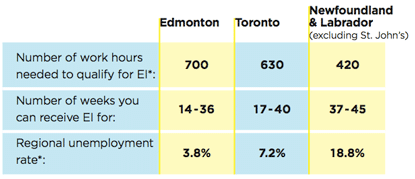Employment Insurance: Help Wanted
Jenn Hardy
Consumer confidence and stock values might be dropping, but there’s one number that’s on the rise: Canada’s unemployment rate. As more Canadians start turning to Employment Insurance, we got to wondering about the specifics. EI schemes vary widely across the country, it turns out. Just how extreme are the differences? Well, here’s what we found:

* December 2008 StatsCan figures. These have likely risen since then.
While at first glance it might look like the federal government is playing favourites, with benefits starting earlier and lasting longer in Newfoundland and Labrador, these regional inequalities actually make a lot of sense.
Explains Julie Hahn from Human Resources and Skills Development Canada: “When a region’s unemployment rate increases, the entrance requirement is relaxed and the benefit duration is extended to allow more time for a successful job match.”
This is why Newfoundland and Labrador, with unemployment rates nearly five times Edmonton’s, sees their residents eligible for EI at the minimum number of 420 hours, while Edmontonians need to work the maximum 700 hours.
So while the schemes aren’t equal, they are designed to be fair. If only last year’s EI surplus, which topped more than $50 billion, was handled with such care. That money, which could have been used to support laid-off manufacturing workers, was instead funnelled into the government’s general revenues, where it helped pay off the national debt — and cover corporate tax cuts.